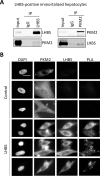Aerobic glycolysis supports hepatitis B virus protein synthesis through interaction between viral surface antigen and pyruvate kinase isoform M2
- PMID: 33720996
- PMCID: PMC8009439
- DOI: 10.1371/journal.ppat.1008866
Aerobic glycolysis supports hepatitis B virus protein synthesis through interaction between viral surface antigen and pyruvate kinase isoform M2
Abstract
As an intracellular pathogen, the reproduction of the hepatitis B virus (HBV) depends on the occupancy of host metabolism machinery. Here we test a hypothesis if HBV may govern intracellular biosynthesis to achieve a productive reproduction. To test this hypothesis, we set up an affinity purification screen for host factors that interact with large viral surface antigens (LHBS). This identified pyruvate kinase isoform M2 (PKM2), a key regulator of glucose metabolism, as a binding partner of viral surface antigens. We showed that the expression of viral LHBS affected oligomerization of PKM2 in hepatocytes, thereby increasing glucose consumption and lactate production, a phenomenon known as aerobic glycolysis. Reduction of PKM2 activity was also validated in several different models, including HBV-infected HepG2-NTCP-C4 cells, adenovirus mediated HBV gene transduction and transfection with a plasmid containing complete HBV genome on HuH-7 cells. We found the recovery of PKM2 activity in hepatocytes by chemical activators, TEPP-46 or DASA-58, reduced expressions of viral surface and core antigens. In addition, reduction of glycolysis by culturing in low-glucose condition or treatment with 2-deoxyglucose also decreased expressions of viral surface antigen, without affecting general host proteins. Finally, TEPP-46 largely suppressed proliferation of LHBS-positive cells on 3-dimensional agarose plates, but showed no effect on the traditional 2-dimensional cell culture. Taken together, these results indicate that HBV-induced metabolic switch may support its own translation in hepatocytes. In addition, aerobic glycolysis is likely essential for LHBS-mediated oncogenesis. Accordingly, restriction of glucose metabolism may be considered as a novel strategy to restrain viral protein synthesis and subsequent oncogenesis during chronic HBV infection.
Conflict of interest statement
The authors have declared that no competing interests exist.
Figures









Similar articles
-
Intrahepatic hepatitis B virus large surface antigen induces hepatocyte hyperploidy via failure of cytokinesis.J Pathol. 2018 Aug;245(4):502-513. doi: 10.1002/path.5102. Epub 2018 Jul 4. J Pathol. 2018. PMID: 29862509
-
Hepatitis B virus pre-S2 mutant large surface protein inhibits DNA double-strand break repair and leads to genome instability in hepatocarcinogenesis.J Pathol. 2015 Jul;236(3):337-47. doi: 10.1002/path.4531. Epub 2015 Apr 22. J Pathol. 2015. PMID: 25775999
-
Hepatitis B virus and hepatitis C virus interaction in Huh-7 cells.J Hepatol. 2009 Sep;51(3):446-57. doi: 10.1016/j.jhep.2009.04.025. Epub 2009 Jun 3. J Hepatol. 2009. PMID: 19596477
-
Association of the Hepatitis B Virus Large Surface Protein with Viral Infectivity and Endoplasmic Reticulum Stress-mediated Liver Carcinogenesis.Cells. 2020 Sep 8;9(9):2052. doi: 10.3390/cells9092052. Cells. 2020. PMID: 32911838 Free PMC article. Review.
-
Molecular mechanistic insight of hepatitis B virus mediated hepatocellular carcinoma.Microb Pathog. 2019 Mar;128:184-194. doi: 10.1016/j.micpath.2019.01.004. Epub 2019 Jan 3. Microb Pathog. 2019. PMID: 30611768 Review.
Cited by
-
The Antiviral Effects of 2-Deoxy-D-glucose (2-DG), a Dual D-Glucose and D-Mannose Mimetic, against SARS-CoV-2 and Other Highly Pathogenic Viruses.Molecules. 2022 Sep 12;27(18):5928. doi: 10.3390/molecules27185928. Molecules. 2022. PMID: 36144664 Free PMC article. Review.
-
Effect of Lactate on Epigenetic Regulation in the Development of Hepatitis B Virus-related Hepatocellular Carcinoma.J Clin Transl Hepatol. 2022 Oct 28;10(5):786-787. doi: 10.14218/JCTH.2022.00274. Epub 2022 Jul 26. J Clin Transl Hepatol. 2022. PMID: 36304502 Free PMC article. No abstract available.
-
Ca2+/Calmodulin-Dependent Protein Kinase II Inhibits Hepatitis B Virus Replication from cccDNA via AMPK Activation and AKT/mTOR Suppression.Microorganisms. 2022 Feb 23;10(3):498. doi: 10.3390/microorganisms10030498. Microorganisms. 2022. PMID: 35336076 Free PMC article.
-
Epidemiology of hepatitis delta virus (HDV) infection and comparison of clinical characteristics and disease progression among patients with HDV vs. hepatitis B mono-infection: real-world data from a large healthcare insurer-provider in Israel.Virol J. 2025 Aug 6;22(1):271. doi: 10.1186/s12985-025-02897-2. Virol J. 2025. PMID: 40770746 Free PMC article.
-
What role for cellular metabolism in the control of hepatitis viruses?Front Immunol. 2022 Nov 17;13:1033314. doi: 10.3389/fimmu.2022.1033314. eCollection 2022. Front Immunol. 2022. PMID: 36466918 Free PMC article. Review.
References
Publication types
MeSH terms
Substances
LinkOut - more resources
Full Text Sources
Other Literature Sources
Medical
Research Materials
Miscellaneous

